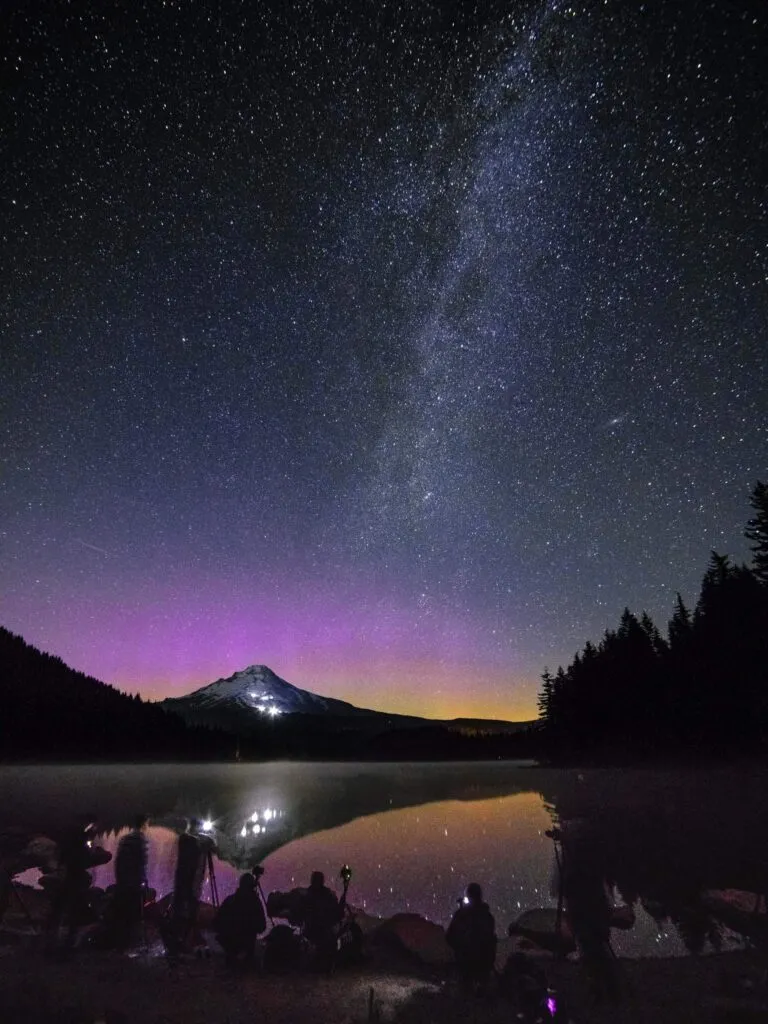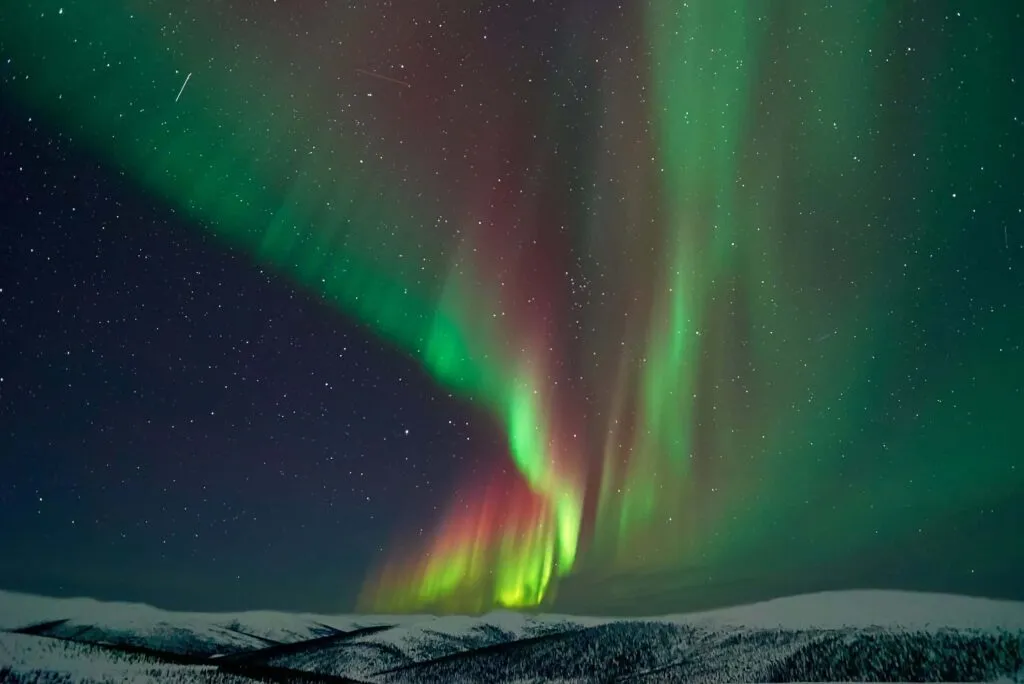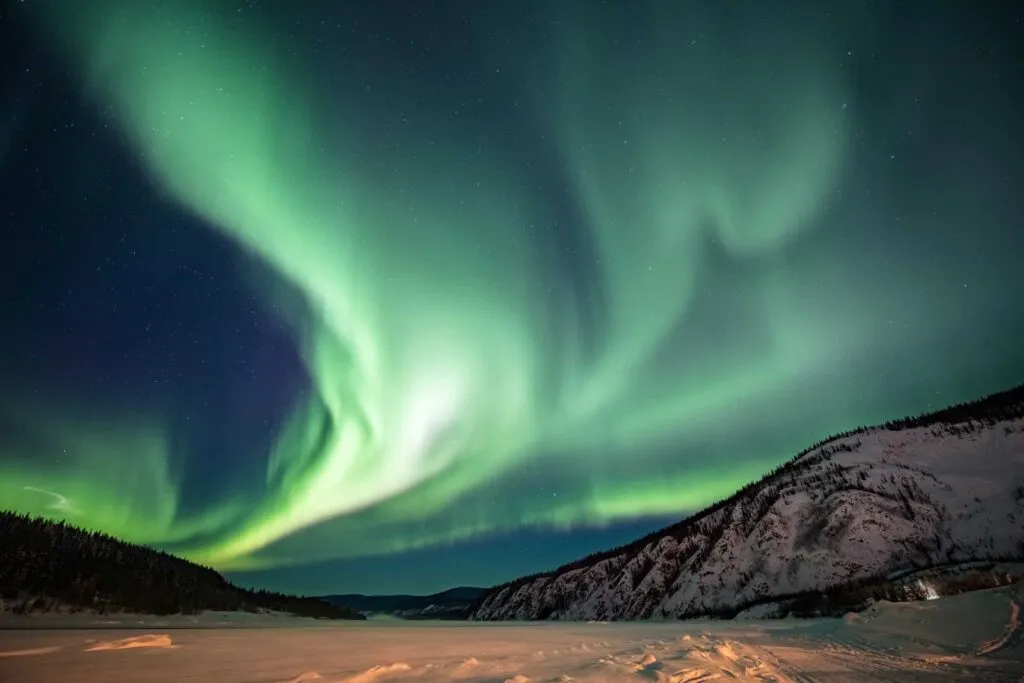Entrancing, dramatic, magical and named after the Roman goddess of dawn, the northern lights are Mother Nature’s proud light show, a pulsating and iridescent celestial ballet that paints the night sky with vivid streaks of colour. But to see this natural phenomena in all its beauty, you need to head north. Here, we pick out some of the most accessible places to witness the spectacle in the USA & Canada.
Bands and swirls of colour dance high in the earth’s atmosphere and paint the night sky in an ethereal, magical form as highly charged electrons from solar wind collide with atmospheric elements near the North Pole. The aurora borealis have to be seen to be believed.
What causes the aurora borealis?
The lights occur when electrically charged particles from the sun collide with gases like nitrogen and oxygen in the earth’s atmosphere. Openings in the sun’s atmosphere (such as sunspots) allow electrons and protons to flow out and can be blown towards the earth on solar winds. Generally these particles are deflected by the earth’s magnetic field, but where this is weaker – at the north and south poles – they can enter. When a lot of these charged particles collide with gases in the earth’s atmosphere, then we are treated to the swirling displays of the northern lights. The most common aurora colours are yellow and green due to collisions with oxygen molecules. However, collisions with nitrogen can produce red, violet, and sometimes blue colours. The type of collision with the gases as well as the altitude of the collision can also affect the colours.
Where can I see the northern lights?
Aurorae happen at both magnetic poles: the aurora borealis are the northern lights, occuring in the northern hemisphere, whereas the aurora australis are the southern lights, occuring in the southern hemisphere. The northern hemisphere is far more accessible to see the aurora though, as the magnetic south pole is in Antarctica and therefore not as easy to get to (although strong solar storms can sometimes mean the lights are seen from Tasmania and south of Australia). The aurora borealis can be seen most vividly across North America and northern Europe.

What tips are there for the best lights experience?
Getting as close to the magnetic poles as possible will increase your chance of witnessing the aurora borealis, but remember that being a natural phenomena the lights are unpredictable and not guaranteed. Other important factors include getting out of cities and away from light pollution; the darker the skies the better (and that makes for some epic stargazing too!). Plus, it can help being on higher ground to get an unobstructed view. If it’s a cloudy sky the night you’re aurora hunting, you’ll likely have to try another night or drive around looking for gaps in the cloud; the aurora aren’t usually visible through clouds. The aurora lights are continuously happening, but most of the time can’t be seen. During winter is the best time to see them thanks to darker, clearer nights and cold air; September through to April can provide the best chance to see the lights. The sunspots and solar storms causing the light shows also happen on an 11-year cycle, so keeping up to date with aurora forecast in the area you’re travelling to will help you get the best chance of witnessing the phenomena.
Seeing the aurora borealis in the USA & Canada
It’s true that the closer to the magnetic North Pole you go, the better your chance of seeing the northern lights. However, getting to Nunavut in Canada or the far northern reaches of the Arctic isn’t always possible for everyone. Thankfully there are some much more accessible spots around to chase the northern lights.
America
The northern states of America provide an excellent chance to see the aurora borealis, with many places accessible from major international airports. We’ve narrowed the list down to our pick of the three best states to try your chances.
Alaska
Alaska’s geographic location mixed with endless winter dark skies and crisp air mean the American state is a great place to see the aurora borealis dancing in all their joy. Raw and untamed, the mountains and lakes of Denali National Park & Preserve provide the perfect backdrop to the swirls and streaks of the northern lights, and thanks to the lack of light pollution, the park makes for one of the best viewing spots of the lights in the US. The park can only be accessed by one road, adding to the sense of remoteness and brilliant wilderness of the six million acre park. Meanwhile, Fairbanks, located less than 200 kilometres from Denali National Park and with an international airport in the city, is one of the most popular locations to hunt for the aurora in Alaska. Thanks to its location in the auroral oval (an area around the North Pole where aurorae are frequent), the light show is pretty reliable and there are many operators in the area offering tours to see the lights.

Best airports to fly to in Alaska:
Fairbanks International Airport and Ted Stevens Anchorage International Airport are the best airports to fly to if you’re chasing the northern lights in Alaska. There is also plenty of accommodation, meaning both Fairbanks and Anchorage make a good base for exploration. Transfers from both airports to Fairbanks are available on Jayride.com. Fairbanks city is a couple of hours’ drive to the entrance of Denali National Park, whereas it’s around four hours from Anchorage.
Idaho
The northern reaches of the state of Idaho, bordering Canada, is another great location for spotting the northern lights. The Idaho Panhandle National Forest and popular spot of Priest Lake welcome northern lights chasers and photographers each year thanks to the dark and clear skies. If you’re lucky and the lights are in full swing, you may even get double the goods; the lights can often reflect in the lake, providing a mirrored reflection set against a mountainous backdrop. Perfect.
Best airport to fly to in Idaho:
The nearest city serving Priest Lake is Spokane in the neighbouring state of Washington, which is home to Spokane International Airport. It’s just a couple of hours’ drive to the lake from the airport, while the city itself makes a good base to start your trip. Transfers to and from Spokane International Airport to Spokane city start from as little as USD$25 on Jayride.com.
Minnesota
Cook County along the shores of Lake Superior in the north of Minnesota is often touted by enthusiasts as a great spot to watch the northern lights dance in the night sky. With Minnesota’s tallest mountains as a backdrop, you can watch the lights reflect in the waters of the huge Lake Superior – the largest of the Great Lakes in North America.
Best airport to fly to in Minnesota:
Minneapolis–Saint Paul International Airport is the largest international airport to fly to if visiting the area, and is around 400 kilometres from the Cook County area. This major city forms the ‘Twin Cities’ with neighbouring state capital St Paul, and is a great base on a trip to see the northern lights in this area, with all the trimmings of a thriving cosmopolitan city. Shared shuttles from Minneapolis-Saint Paul International Airport to downtown Minneapolis start from just USD$18 on Jayride.com.
Canada
Canada is probably the best place in the world to see the northern lights in all their glory. The Yukon, Nunavut and the Northwest Territories provide some of the best backdrops if you have the time to play with.
According to the capital (and only) city of Northwest Territories, Yellowknife is the undeniable choice for seeing the northern lights. It’s said that visitors have a 90 per cent chance of seeing the lights in the winter months here, making it a good pick if you have the time to get up to the remote area. The city is 400 kilometres south of the Arctic Circle, so be prepared for the sub-zero temperatures! But you’ll be rewarded with incredible vistas of snow and ice, as well as Canada’s deepest lake, Great Slave.
The capital of the Yukon Territory, Whitehorse, is a popular destination for seeing the northern lights as there are many tours that run in the area throughout the winter. You can take a flight from major international hubs like Vancouver and Calgary to reach Erik Nielsen Whitehorse International Airport, so if you have the time it’s well worth the visit up north.

Known as the ‘polar bear capital of the world’, Churchill in Manitoba is reported to be in the top three places in the world to see the northern lights and rumours have it that the lights can be seen 300 days a year. The area is remote and no roads go into the city, so the best ways to get to the area are by air or rail. But it’d be well worth the trek to see the lights from an Aurora Dome (plexiglass bubble domes where you can stay warm while seeing all the glory of the lights!).
If you’re visiting British Columbia, you’ll likely have to travel far from the main hub of Vancouver to see the lights. Muncho Lake Provincial Park in the far north of BC and near the Yukon Territory offers the incredible backdrop of the Canadian Rockies with common sightings of the northern lights.
Not everyone has time on their side though, so if you’re wanting to stick to some more accessible places closer to major international hubs, fear not! Alberta and Saskatchewan should be top of your list.
Alberta
Jasper National Park is a fantastic choice for catching the aurora borealis, and is accessible from both major hubs of Edmonton and Calgary. Located in the Canadian Rockies, Jasper National Park is one of the world’s largest and accessible Dark Sky Preserves (a Dark Sky Preserve makes all effort to preserve the night sky and reduce all forms of light pollution), meaning it not only makes a fantastic spot for watching the northern lights, but you’ll also get to some of the most amazing stargazing possible. Aurora borealis and the Milky Way? Now we’re talking!
Best airports to fly to in Alberta:
Both Edmonton International Airport and Calgary International Airport are the best airports to fly to if visiting the area.
Saskatchewan
It is said the Saskatchewan is where you’ll find some of the clearest and darkest skies in Canada, making the province perfect for spotting the northern lights; the license plate slogan of ‘land of the living skies’ rings true for this state. The towns of La Ronge and Melfort are cited as great spots to see the lights, with the latter often referred to as the ‘city of the northern lights’ thanks to the common appearance of the aurora. Being a prairie and boreal province, the land is mostly flat meaning that the night skies seem endless and provide the perfect canvas as the northern lights paint the sky.
Best airport to fly to:
Most visitors will likely base themselves in the cities of Saskatoon and Regina, and explore from there. Transfers are available from both Regina Airport and Saskatoon Airport on Jayride.com.
Don’t miss your chance to watch the other-worldly aurora borealis colour the skies above you, and pre-book your airport transfer in Canada or the USA before you fly. For more inspirational tips on what to see and do in Canada, check out our blog.
